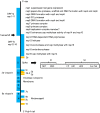A Defective Viral Particle Approach to COVID-19
- PMID: 35053418
- PMCID: PMC8774189
- DOI: 10.3390/cells11020302
A Defective Viral Particle Approach to COVID-19
Abstract
The novel coronavirus SARS-CoV-2 has caused a pandemic resulting in millions of deaths worldwide. While multiple vaccines have been developed, insufficient vaccination combined with adaptive mutations create uncertainty for the future. Here, we discuss novel strategies to control COVID-19 relying on Defective Interfering Particles (DIPs) and related particles that arise naturally during an infection. Our intention is to encourage and to provide the basis for the implementation of such strategies by multi-disciplinary teams. We therefore provide an overview of SARS-CoV-2 for a multi-disciplinary readership that is specifically tailored to these strategies, we identify potential targets based on the current knowledge of the properties and functions of coronaviruses, and we propose specific strategies to engineer DIPs and other interfering or therapeutic nanoparticles.
Keywords: COVID-19; antivirus; aptamer; coronavirus; defective interfering particle; extracellular vesicle; immunity; synthetic defective viral genome; therapy.
Conflict of interest statement
The authors declare no conflict of interest. The funders had no role in the in the writing of the manuscript, or in the decision to publish it.
Figures


References
-
- Ganem D.E. 2000 and Beyond: Confronting the Microbe Menace Lecture One—Microbe Hunters: Tracking Infectious Agents. [(accessed on 9 June 2020)]. Available online: https://www.biointeractive.org/sites/default/files/Infectious%2520Diseas....
-
- Sun Y., Jain D., Koziol-White C.J., Genoyer E., Gilbert M., Tapia K., Panettieri R.A., Jr., Hodinka R.L., Lopez C.B. Immunostimulatory defective viral genomes from respiratory syncytial virus promote a strong innate antiviral response during infection in mice and humans. PLoS Pathog. 2015;11:e1005122. doi: 10.1371/journal.ppat.1005122. - DOI - PMC - PubMed
Publication types
MeSH terms
Grants and funding
LinkOut - more resources
Full Text Sources
Medical
Miscellaneous

